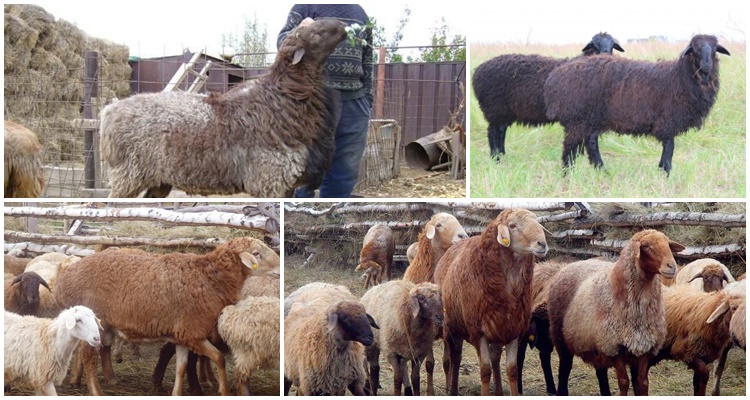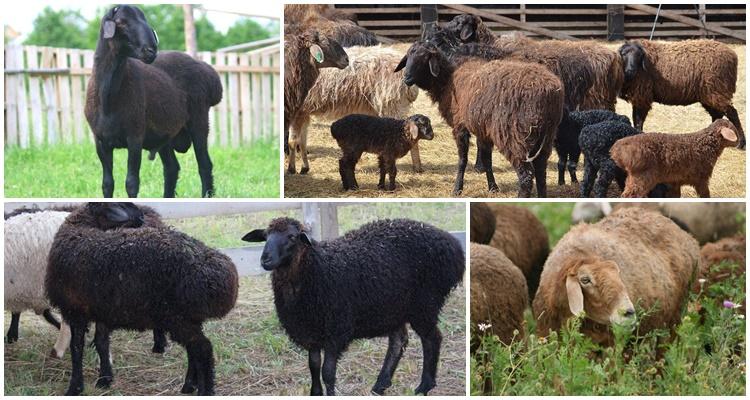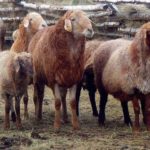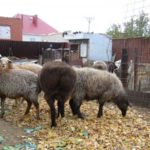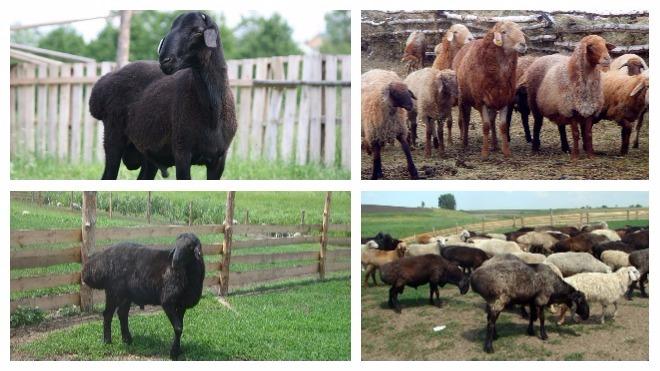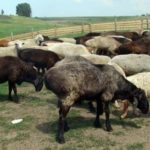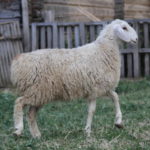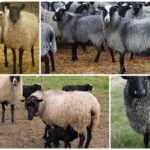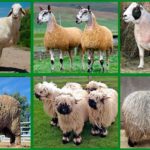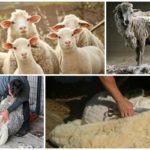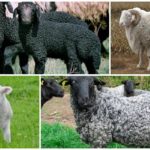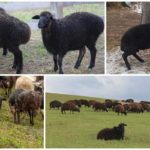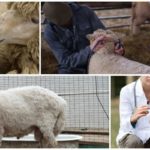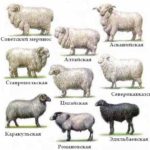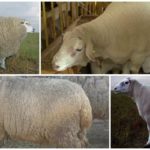Sheep breeders value ease of care, endurance, meat, fat and milk productivity in Edelbai sheep. The Edilbaevskaya breed of sheep was bred specifically for the arid and sparsely vegetated steppe regions. Unpretentious animals of the fat-tailed type are adapted to multi-day transitions between pastures, frosty winters and dry summers, and gain weight on stunted pasture.
History of the breed
Breeders obtained the Edilbaevskaya breed in the 19th century by crossing a fat-tailed Kazakh sheep with an Astrakhan ram. During the selection process, experts selected the strongest and hardiest offspring, highly adaptable to both drought and severe frost, capable of traveling long distances without losing weight, feeding on stunted steppe grass.
Representatives of the Edelbai breed are distinguished by their fertility and produce not only meat, but also valuable fat tail fat. The breed was liked by shepherds roaming the steppes and semi-deserts of Kazakhstan. The fat that accumulates in the fat tail allows the sheep's body not to lose meat and milk productivity in the unfavorable climate of the steppe zone.
For several decades, the Edilbaev breed was bred by Kazakh sheep breeders. By the 1950s, the unpretentious and productive breed became popular in other Soviet republics. Today, Edilbaev sheep are raised by Kazakh, Uzbek, and Ukrainian livestock breeders.
Appearance and characteristics
Edilbaevsky sheep belong to the fat-tailed type. In the sacral region, they accumulate fat mass, forming a fat tail, which grows as the animal ages.
External signs and characteristic features of the Edilbaevsky breed are given in the table.
| Height at withers | 80-85 cm |
| chest girth | up to 1 m |
| weight | ram – 110-120 kg, sheep – 65-70 kg |
| color | black (traditional), brown (dark and light), red |
| horns | none |
| torso | strong, well-built, with smooth outlines and a developed skeleton, the spine is strong and flexible, the back of the body looks more massive than the front |
| head | medium size, narrowed, with an elongated muzzle and a humped back of the nose, strong and thick teeth, adapted for eating coarse plant food |
| limbs | strong, sinewy, slender, with well-developed muscles |
| wool | dense, thick, has a thermal insulation property, the length of the hairs is 10-15 cm, half of the wool mass is fluff |
Lambs actively gain weight from the first day of life. A newborn male cub weighs on average 6 kg, female – 5.2-5.5 kg. The average daily weight gain of a lamb up to 3 months of age is 200-250 g, and males develop more slowly than females.
A young individual of 4 months of age weighs up to 25 kg, and the weight of the fat tail reaches 3 kg. Edilbaevsky sheep, which have reached 5-7 months, are suitable for slaughter, weighing up to 40 kg, with half of the weight being slaughter, and 4 kg being fat tail fat mass. The productivity of Edilbaevsky sheep depends on color. Black animals are more productive in terms of meat and wool.
Advantages and disadvantages of Edelbaev sheep
Requirements for maintenance and care
Despite their endurance and high adaptability, Edelbaev sheep need good living conditions. The barn must be clean and the bedding must be dry.High air humidity is unacceptable; it negatively affects the immune system and productivity of livestock. The temperature in the barn should not be allowed to drop below +8 °C; during the winter months, the heating must be turned on in the room.
A sedentary lifestyle negatively affects the muscle mass and general well-being of Edilbaev sheep. Therefore, the herd must be walked daily.
Edilbaev sheep are supposed to be sheared once every 10 months. But some sheep farmers do this more often - once every 6 months - to prevent dermatological and parasitic diseases.
What to feed the animals
The basis of the sheep diet is fresh pasture grass, which the animals eat at least 200 days during the year. Moreover, sheep are able to find grass even under the snow, if its layer is low.
Edilbaevsky sheep are transferred to roughage as a last resort: when a snowy winter does not allow continued grazing, or when precipitation has fallen and the vegetation on the pasture has become damp.
The daily portion of food for one individual is 2 kg of hay, 1 kg of grain concentrates. In winter, Edilbaev's sheep are given bran, cake, silage, and root vegetables to intensively gain muscle mass and replenish vitamin deficiencies. The best option for mineral supplements is salt stone, which can be purchased at a pet store. Animals must have clean water available at all times.
Nuances of breeding
Edilbaevsky sheep are characterized by low fertility. A single lamb is born 1-2 times a year. It is very rare for a sheep to have two babies. Females reach sexual maturity by 7 months of age.For pregnancy to occur, the female must be inseminated several times. Breeding males remain productive until 5 years of age. The strongest and healthiest individuals are selected for mating, and a corresponding mark is placed on their ear.
The Edilbaevskaya sheep is pregnant for 5 months. The birth process lasts about an hour. Edelbaev sheep give birth on their own; human assistance is not required.
The owner only needs to prepare the birth stall, clean it of dirt and manure, put fresh bedding, and trim the hair around the external genitalia of the giving birth female.
Possible complications during childbirth are the appearance of the baby in the amniotic sac or its getting stuck in the birth canal due to incorrect position. In these cases, you need to urgently call a veterinarian. The owner cleans the newborn lamb's nasal passages and oral cavity of mucus. There is no need to wash the baby: the mother will lick it herself. The female and the lamb are kept in a separate pen.
Breed diseases and possible problems
The immunity of Edelbaev sheep is strong, but certain diseases occur:
- Tick-borne encephalitis. The carrier is a tick that moves onto the skin of animals from pasture grass. A sick sheep's temperature rises, and if left untreated, the nervous system is affected.
- Smallpox is a viral pathology that is fatal.
- Listeriosis is a bacterial disease that affects the nervous system, reproductive organs, and mammary glands. If left untreated, the sick animal becomes paralyzed and dies.
- Melophagosis is a parasitic disease that affects the skin. The parasite is a wingless fly called the sheep's bloodsucker. The insect lays eggs in the sheep's wool. The infected animal suffers from unbearable itching and loses weight.
- White muscle disease occurs in lambs with hypovitaminosis.In a sick animal, coordination of movements is impaired, convulsions occur, and muscle tone decreases.
- Helminthiasis is damage to the intestines by worms. Sheep ingest larvae in pasture grass. If left untreated, there is a high risk of fatal hemorrhage in the digestive tract.
- Infectious mastitis in females is accompanied by the appearance of purulent ulcers on the mammary glands. In advanced cases, the animal dies.
- Flatulence is swelling of the scar of the stomach.
- Bezoar disease of young animals is a perversion of appetite due to violations of feeding rules. The lamb plucks and swallows its wool, eats soil, sawdust, and rags. As a result, undigested lumps accumulate in the abomasum, interfering with the movement of food.
Breeding prospects
Farmers obtain wool, meat, fat, and milk from Edilbaev sheep. Fat tail fat, rich in vitamins and nutrients, is used for culinary purposes and to create cosmetics. The weight of meat obtained after slaughter reaches 50-60% of the animal’s body weight. The fat tail weighs 4-5 kg, and the weight of the fat contents is about 1 kg. One sheep provides a person with 4 kg of wool.
Lactation lasts 4 months. The amount of milk obtained from Edilbaev sheep is small, but the product is fatty and suitable for the production of sour cream, cheeses, and cottage cheese. For dairy production to be profitable, the farm must have at least 15 milking animals. The coarse wool of Edilbaev sheep is suitable for the production of carpets and winter wardrobe items. Residents of the steppe regions of Kazakhstan use sheep skin to produce comfortable and wearable clothing.
The most productive in terms of meat are rams that are six months old.It is unprofitable to raise a meat breed for longer, since the meat of aging Edilbaev sheep is not in demand. Meat and lard products are exotic, popular only in the steppe regions, where local dishes are prepared from them. This should be taken into account when drawing up a business plan for a person who decides to breed the Edilbaev breed.
Approximate cost and where to buy
The Edilbaevskaya breed is popular. Pedigree sheep are sold both by large breeding enterprises and by private owners engaged in sheep breeding. It is better to contact breeding farms, where breed qualities are more carefully controlled and individuals with genetic pathologies are rejected.
The price for an Edilbaev sheep is determined by the status and reputation of the farm, the health and breed qualities of the animals, and the region where the livestock is raised. On average, a healthy purebred lamb costs $200.
Edilbaevskaya is a productive breed of sheep that adapts to the most severe climatic conditions. The unpretentiousness of the Kazakh breed contributed to its rapid popularization. However, the quality of meat and lard products depends on the maintenance and feeding, and the regularity of pasture walking.

